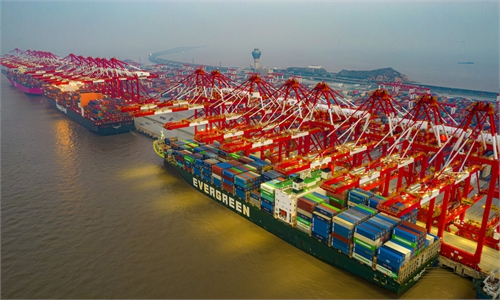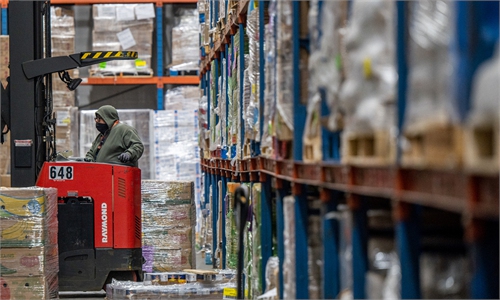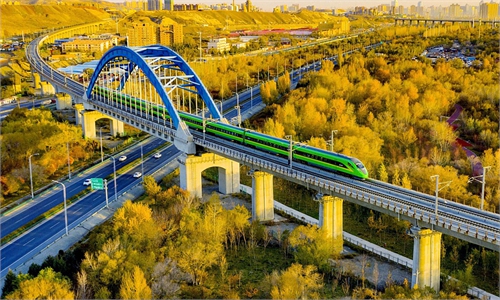
Illustration: Chen Xia/Global Times
While an overwhelming and growing majority of Americans say the US economy is headed in the wrong direction, crippled by skyrocketing inflation and American consumers' shrinking pocketbooks, the Chinese economy is firing on all cylinders now to make up for the slack or dent in April and May's figures, as coronavirus lockdowns in Shanghai and parts of Beijing, Shenzhen and other megacities caused a significant slump of economic activity.June and the first half of this month has shown the world's second largest economy is rapidly rebounding. In June, China's juggernaut export machine again displayed its full force, as outbound shipments grew 17.9 percent, hitting $331 billion, the quickest growing pace in the first six months as COVID-19 restrictions eased. Chinese consumers' buying power has also rebounded from June, giving the economy another boost. The economy will thrive in the second half of 2022.
In order to reach an annual GDP expansion of more than 5 percent over 2021, China's central government has launched a basket of monetary and fiscal stimulus measures, including tax exemptions and rebates, incremental bond sales by local governments and reduction of the benchmark loan prime rates (LPR). Also, the government has moved to liberate the economy through a series of deregulatory moves, while making the country's financial markets wider open to overseas capital.
China's GDP grew 2.5 percent in the first half of 2022, the country's statistics authority said on Friday. It won't be easy to achieve the 5.5 percent growth, preset at the National People's Congress (NPC) in March, as the world is facing a myriad of uncertainties, ranging from the unabated global spread of coronavirus variants, red-hot inflation and an economic contraction in the US and nearly all other major economies, as well as aggravated geopolitical tensions and severely disrupted global supply lines of fuel, grain, fertilizer and semiconductors.
However, China is endowed with a hard-won advantage - low inflation, thanks to the country's ample supply of agricultural products, vegetables, fruits, eggs and pork in particular. The massive supply of inexpensive work force has helped empower the country's giant manufacturing industry, able to maintain the prices of many manufactured products at a low level.
Also, China has attained a significant foreign trade surplus - $97.94 billion in June alone - which has largely cushioned the yuan's exchange rate with the world's other major currencies and helped keep domestic inflation at bay. In sharp contrast, the euro, British pound, Japanese yen and Indian rupee all plunged against the US dollar, as the US Federal Reserve kicked off its cycle of monetary tightening by raising interest rates steeply to rein in 8.6 percent inflation in May and 9.1 percent inflation in June.
In the second half of 2022, China could continue to keep its monetary spigots proportionately open to provide sufficient liquidity so as to support internal investment and consumption growth. In time of global economic difficulties, this country has, time and again, resorted to heavy investment on improving infrastructure projects and upgrading manufacturing technology to help weather economic downturns, and miraculously, the country has always come out of the downturns in a better shape, with enhanced industrial competitiveness and technological innovations among the nations.
For an example, owing to Beijing's persistent support of green technology, the country has invested significantly on hydropower equipment, solar panels, wind turbines, nuclear power reactors and electric buses and cars. Now, Chinese production in these areas is leading the world. In June, China exported 248,000 vehicles, up 30.5 percent from a year earlier, of which, electric vehicles accounted for about one fifth, making the country a heavyweight producer and export of new energy vehicles.
Resulting from a strong rebound in bank lending and newly added government bond sales, China's credit jumped much more than expected in June to the highest on record. Aggregate financing, a broad measure of credit, hovered at 5.2 trillion yuan ($777 billion) in June, the People's Bank of China, the central bank said last week. It was the highest for any June in comparable data back to 2017 and beat the consensus estimate of 4.2 trillion yuan. Naturally, the end of the lockdown in Shanghai and other Chinese cities has contributed to the increase in borrowing demand.
On the contrary, the world's other major economies are currently being forced to raise interest rates by 50 to 75 basis points apiece to curb runaway inflation. Heightened borrowing rates will inevitably stifle consumer and corporate loans and cause a taper-off of economic growth. The economies of the US, Europe and Japan are broadly estimated to contract or even recede starting late this year and in 2023.
Facing the "triple economic pressures" including uncertain demand, supply shocks and weak expectations, China's two-pronged "Internal and External Circulation" development strategy will come to the fore. Robust infrastructure investment and export will again prove the strong resilience of Chinese economy. Helped by the RCEP free trade deal and the iconic Belt and Road Initiative, China and its close partners in ASEAN may witness GDP growths of higher than 4 percent this year, giving the world a light of hope in time of economic agony and political tumult.
The author is an editor with the Global Times. bizopinion@globaltimes.com.cn



